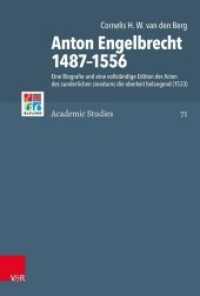- ホーム
- > 洋書
- > 英文書
- > History / World
Full Description
Our period opens at the end of the Roman Empire when intellectual currents are indebted to the Greek philosophical inheritance of Plato and Aristotle, as well as to a Romanized Stoicism. Into this mix entered the new, and from 313CE imperially sanctioned, religion of Christianity. In art, literature, music, and drama, we find an increasing emphasis on the arousal of individual emotions and their acceptance as a means towards devotion. In religion, we see a move from the ascetic regulation of emotions to the affective piety of the later medieval period that valued the believer's identification with the Passion of Christ and the sorrow of Mary. In science and medicine, the nature and causes of emotions, their role in constituting the human person, and their impact on the same became a subject of academic inquiry. Emotions also played an increasingly important public role, evidenced in populace-wide events such as conversion and the strategies of rulership. Between 350 and 1300, emotions were transformed from something to be transcended into a location for meditation upon what it means to be human.
Contents
List of Illustrations
Series Editors' Preface
Introduction, Clare Monagle (Macquarie University, Australia)
1. Medical and Scientific Understandings, Nicole Archambeau (Colorado State University, USA)
2. Religion and Spirituality, Daniel Anlezark (University of Sydney, Australia)
3. Music and Dance, Constance J. Mews (Monash University, Australia) and Carol Williams (Monash University, Australia)
4. Drama, Sarah Jane Brazil (University of Geneva, Switzerland)
5. The Visual Arts, Katherine Boivin (Bard University, USA)
6. Literature, Juanita Feros Ruys (University of Sydney, Australia)
7. In Private: The Individual and the Domestic Community, Lisa Perfetti (Whitman College, USA)
8. In Public: Collectivities and Polities, Jehangir Malegam (Duke University, USA)
Notes
Bibliography
Notes on Contributors
Index


![EPINE PARIS QUILTING BAG BOOK PINK [バラエティ]](../images/goods/ar2/web/imgdata2/42990/429906173X.jpg)





